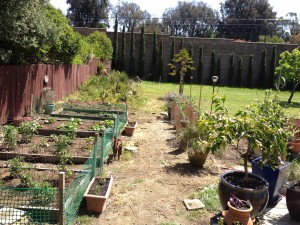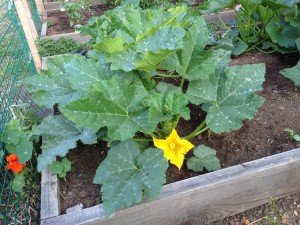 The first of my harvest has arrived with a bloom and ka-boom!
The first of my harvest has arrived with a bloom and ka-boom!
About 6 weeks ago I planted a number of tender little shoots. Some tomatoes, some peppers, an eggplant, a few watermelon and a handful of squash; zucchini, yellow crook neck and patty pan to be precise. This last week these little charges bore the fruits of MY labor. In my post Organic IS Marketing Hype you will see the early photos of my garden and my very first squash blossom of the season (as seen here). This beautiful little flower yielded the rather rotund patty pan you see below.
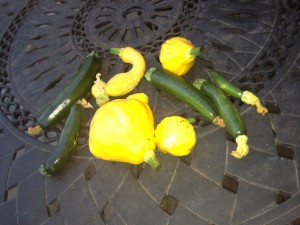
Now every Second Sunday of the Month my friends and I gather around a large table where we drink too much wine, eat too much food and tell each other too, too may lies. Inevitably in this raucous Bacchus caucus, a voice of dubious authority will pipe up and say something like, “These tomatoes taste great but the ones my grandfather grew in his garden were amazing!!” Now while I am not a grandfather I do have a garden and I can state with some authority that the freshly-grown-in-my-own-backyard vegetables do taste amazing!! Luckily I live in California where fresh really is fresh and the quality and variety of produce it truly remarkable. But even they can’t compare to the incredible difference in flavor, color and texture that home grown, fresh-off-the-vine vegetables have. And I must tell you there is something tremendously cool about going out to the garden every night and harvesting my own dinner. In my own little mind I hear the plant gently offering up its fruit that I might live another day. “Dear Mr. Tom, You have been so kind to me. You’ve taken me in and given me this wonderful planting bed to lie in. You feed me, water me, and protect me from vile pestilence. Please accept this offering in small exchange for your love and protection.” or something like that. Out of respect for these noble plants I vow never to waste their efforts.
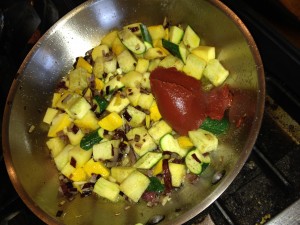 So right after harvesting the mother of all Patty Pan squash I tucked in to it with my 10″ chef’s knife dicing it in to 3/4″ cubes. The remnants of an onion waited patiently in my fridge for just this opportunity. A quick chop put this savory bulb into 1/4″ pieces. This onion, with 3 cloves of garlic smashed, hit the hot olive oil soaked pan with a sizzle. On their heels went my darling Patty Pan.
So right after harvesting the mother of all Patty Pan squash I tucked in to it with my 10″ chef’s knife dicing it in to 3/4″ cubes. The remnants of an onion waited patiently in my fridge for just this opportunity. A quick chop put this savory bulb into 1/4″ pieces. This onion, with 3 cloves of garlic smashed, hit the hot olive oil soaked pan with a sizzle. On their heels went my darling Patty Pan.
Sitting beside this purple read onion of mine I found a tail-end chunk of prosciutto. I sliced off a fat inch and trimmed it into lardons. Into the pan they leapt to join their sauteing brethren. A big fat tablespoon of tomato paste, a cup of white wine, add a big spoon to stir and Voila! Dinner is served.
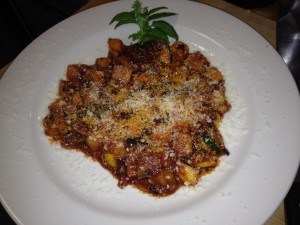
I topped this luscious Ratatouille with a heavy hand of grated Parmesan cheese and a chop-chop of basil. I couldn’t get a fork into it fast enough. Who’s got two thumbs and a mouthful of goodness? This guy!
Eat Well and Smile Often,
tj
p.s. Why is it Rat-atouille? Wouldn’t it sound better being Cat-atouille? (maybe not)

